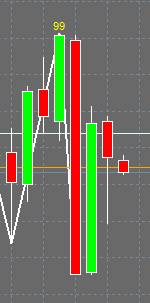- Non-lagging or low-lagging indicators
- Econometrics: one step ahead forecast
- Moving Average Ribbon
And this is a vague term altogether.
How can an indicator be "lagging"? It is exactly like that when it is counted. The MA is not physically "lagging", it is showing the moving average on the bar it is calculated on, where is the "lag"?
All this was invented by those who need an excuse for their improper use of moving averages - they lost their deposits, and who is guilty? Well, of course, the "lagging indicator" is "too late" to show "accurate entries".
Is there a need for one at all? If it is not lagging, it will react to small price movements and will give a lot of false signals. Or does it mean it will not react on such small movements but will not be late when a significant price movement starts? But is it possible?
This may prove to be a lagging conclusion.
And this is a vague term altogether.
How can an indicator be "lagging"? It is exactly like that when it is counted. The MA, for instance, cannot physically "lag", it shows the moving average on the bar it is calculated on, where is the "lag" in it?
All this was invented by those who need an excuse for wrong using of moving indicators - they lost their deposits, and who is guilty? Well, of course, the "lagging indicator" is "too late" to show "accurate entries".
The lag, I think, should be calculated from the last extremum of the zigzag till the time of the signal appearing on the input which was given by the indicator.
The lag, I think, should be counted from the last extremum of the zigzag to the time of the entry signal given by the indicator.
 The display of the next (ascending) trend line or continuation of the current (descending) trend line by the zigzag indicator will occur under certain conditions after some time. This is its lag.
The display of the next (ascending) trend line or continuation of the current (descending) trend line by the zigzag indicator will occur under certain conditions after some time. This is its lag.
Non-tardy, meaning either current or future, not past, not ex post facto.
not past, not ex post facto.
There may be something of a non-lagging one. It is a divergence. No matter what you look at, with the right approach it works.
But it's not essentially an indicator either.
The display of the next (ascending) trend line or continuation of the current (descending) trend line by the zigzag indicator will occur under certain conditions after some time. This is its lag.
For the zigzag to be fully visible, the "graph from above" option must be unchecked.
There may be some non-lagging. It's a divergence. No matter what you look at, with the right approach it works.
The divergence is delayed. In order to identify it, the last extremum must form. And that is already a lag.
Second: when a divergence has been formed, the movement it predicts may be too small.
- Free trading apps
- Over 8,000 signals for copying
- Economic news for exploring financial markets
You agree to website policy and terms of use